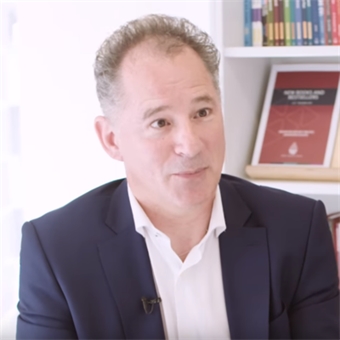The 3 Pillars of Trust: Ability, Integrity and Benevolence

This is an exclusive extract from The Trusted Executive.
Our academic colleagues have shone their forensic light on the word trustworthiness. They have had some fine debates as to the components of trustworthiness.
In the 1970s, Professor John Gabarro of Harvard Business School suggested that trustworthiness resulted from the ability and character of the leader, with ability defined as the skills and knowledge to be successful in the required role and character comprising two further attributes of integrity and benevolence. In the 1980s, other researchers countered by proposing a set of five characteristics of trustworthiness – integrity, competence, consistency, loyalty and openness. Later, in the 1990s, Professor Aneil Mishra and his colleagues defined trustworthiness using the four dimensions of competence, openness, reliability and care.
Thankfully, in 2007, along came Shawn Burke and her research team at the University of Florida to summarize a 30-year debate and conclude that all models of trustworthiness consisted of three common pillars: ability, integrity and benevolence.
Ability
The pillar of ability refers to our professional competence to fulfil the core task of executive leadership: delivering results. You can be as nice as you want to me and honest and open and caring, but if you keep letting me down in terms of delivery, your trustworthiness will be shot.
I’ve worked with a lot of salespeople who I would have trusted implicitly to look after my own children, but I did not trust them to bring in the next big deal. I used to say to them, ‘The problem is that I’m beginning to lose trust in you.’ It surprised them to hear the issue presented in that way. But it was the truth and, sooner or later, it ended up coming back to bite them. Time and time again, the issue of delivery came up in my interviews with CEOs. You can pick up from the following quotes that this is not an area where CEOs see much room for debate:
Trustworthiness is delivering what you say you're going to do.
Trustworthiness is about doing what it says on the tin.
Number one: deliver on your promises. If you say you are going to do something, then do it.
Integrity
The second pillar of integrity refers to the extent to which we ‘walk the talk’. We need to be reliable in our behaviours and consistently live up to the values and standards we have set for ourselves and the organization.
Integrity has an ethical component: it implies honesty, openness and being fair. When I hear people assessing the promotion potential of their team members, the individual’s integrity is often the first topic on the agenda. It is surprising how good people’s memories are when it comes to recalling slips in integrity. A client of mine decided to block the promotion of a highly able leader based on a false expense claim that had been submitted many years ago when the individual had first joined the company. This minor transgression had permanently dented the perception of that individual’s integrity.
In my interviews, here is what CEOs said about integrity:
You can test for integrity in an interview and see if the interviewee pushes back and says 'No, I wouldn't do that, it is wrong.' I want people who can stand up and say 'no'.
I would expect integrity in every employee.
The question about integrity is probably the most important one when it comes to checking references for a new employee - do you have any reason to question the integrity of this individual?
Benevolence
The third pillar of benevolence refers to our concern for the well-being of others. The word comes from the Latin words bene and volent, translated as ‘wishing well’. Benevolence is the opposite of malevolence. We show our good wishes to others through care, generosity and kindness.
I have been in many a boardroom where the leader has publicly humiliated a member of the team through put-downs, sarcasm and withering personal criticism. Those leaders were highly able and as honest as the day is long, but they were not trusted. We could get away with that in the blue pill world because we used authority as a surrogate for trust. Increasingly, this approach will not work in a world where transparency dissolves the traditional levers of authority.
While the CEOs I interviewed did not use the precise word ‘benevolence’, you can detect its presence in the following quotes:
The most powerful destroyer of trust is when you feel the other person is acting in their own best interest and not yours.
A lack of care for the principal stakeholders destroys trustworthiness. Selective care to deliver short-term results. Cherry-picking so that you can live another day.
CEOs low on emotional intelligence will always struggle to generate trustworthiness.
When I first came across the three pillars of trustworthiness, it was the third pillar of benevolence that intrigued me most. In 30 years of leadership development, I had yet to come across this word in any leadership competency framework. I had never been on the ‘Introduction to Benevolence Course for Senior Leaders’. I had not been mentored in compassion, generosity or kindness.
I pondered why this had been the case and then I realized that the agency theory model did not need benevolence to achieve its goal of profit. The agency model outsourced benevolence to other institutions in society. If you brought it into your leadership role then it was a ‘nice to have’ by-product of being a human being but not a ‘must-have’ attribute of leadership.
If we require the new model of business to be built on trust then it is time to insource benevolence. It is time to re-humanize the workplace. I hope that is an exciting prospect!
Putting together the three pillars of trustworthiness gives us the following formula:
trustworthiness = ability × integrity × benevolence
Note that this is a formula involving multiplication, not addition. By the laws of maths, there are two unavoidable consequences of the trustworthiness formula:
- If you score a zero on any one of ability, integrity or benevolence then your trustworthiness will also be zero.
- If you score highly on all three pillars then your trustworthiness will grow exponentially since big numbers multiplied by big numbers produce even bigger numbers!
Executive leaders who focus on building ability, integrity and benevolence in parallel are practising trustworthy leadership. In focusing on the three pillars, we work equally hard to develop our ability to deliver results, our integrity to ‘walk the talk’ and our benevolence to do well to others.
What is more, we set this example in our behaviour, not just with the owners of our business but with all the diverse stakeholders of the modern corporation – staff, customers, suppliers, media, government and the public at large. If we do this rigorously and consistently, we will build reputations as trustworthy leaders.




